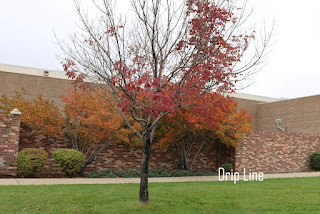When the landscape looks like this in January, it’s easy to overlook the fact that trees need to be watered in the winter. It’s important to understand that trees don’t go into total dormancy during the winter. Underneath the New Year’s snow fall, tree roots are actively looking for moisture and this latest storm did little to hydrate the soil your trees, shrubs and lawn are growing in.
Even though deciduous trees appear to be dormant now, their root systems continue to grow and need moisture to survive. You may not see the damage right away, but trees that don’t receive supplemental watering during the winter may experience smaller leaf production, branch dieback and chlorosis through spring and summer. This is especially true of trees planted this past season that haven’t had time to establish. While more mature trees have the advantage of a larger root system to draw moisture from, newly planted trees need to be watered during the winter to prevent damage and die-back to fine roots. We know it’s important to water trees this time of year. but for winter watering to be effective, there are key factors you need to consider, including temperature, time of day, and sprinkler type. First, pick a day when the ambient temperature is forty degrees or higher and there is no snow on the ground. Plan to water around mid-day, to allow time for the water to soak into the ground.
Use a soft spray attachment such as adjustable hand-held water nozzle, a simple stationary sprinkler or a deep-root needle or fork. Don’t turn your sprinkler system on. Trees take up water best when it is allowed to soak into the soil slowly to a depth of 12 inches. As a general survival rule, apply 10 gallons of water for each diameter inch of the tree. For example, a two-inch diameter tree needs 20 gallons per watering. Use a ruler to measure your tree’s diameter about knee high.
The most important area to water is at the dripline. Tree root systems don’t grow like carrots. They spread horizontally, often two to three times wider than the height of the tree. Water slowly over a wide area. If you notice water beginning to pool and run off, stop watering and allow the soil to absorb the moisture, then resume watering. This cycle and soak method is especially effective if your trees and shrubs are planted in heavy clay soils. Move your sprinkler or soil needle multiple times to ensure the critical root zone within the dripline is well hydrated. While you’re at, water the lawn. Turf grass that is well-hydrated through the winter months is more resistant to insect activity, will start to green up earlier in the spring and typically experiences less die-back through summer’s heat.
Once you’re done watering, be sure to disconnect the hose from the outside faucet. Plan to water your trees, shrubs and lawn every four to five weeks through the winter season, considering any natural moisture we may receive during the same period.





No comments:
Post a Comment